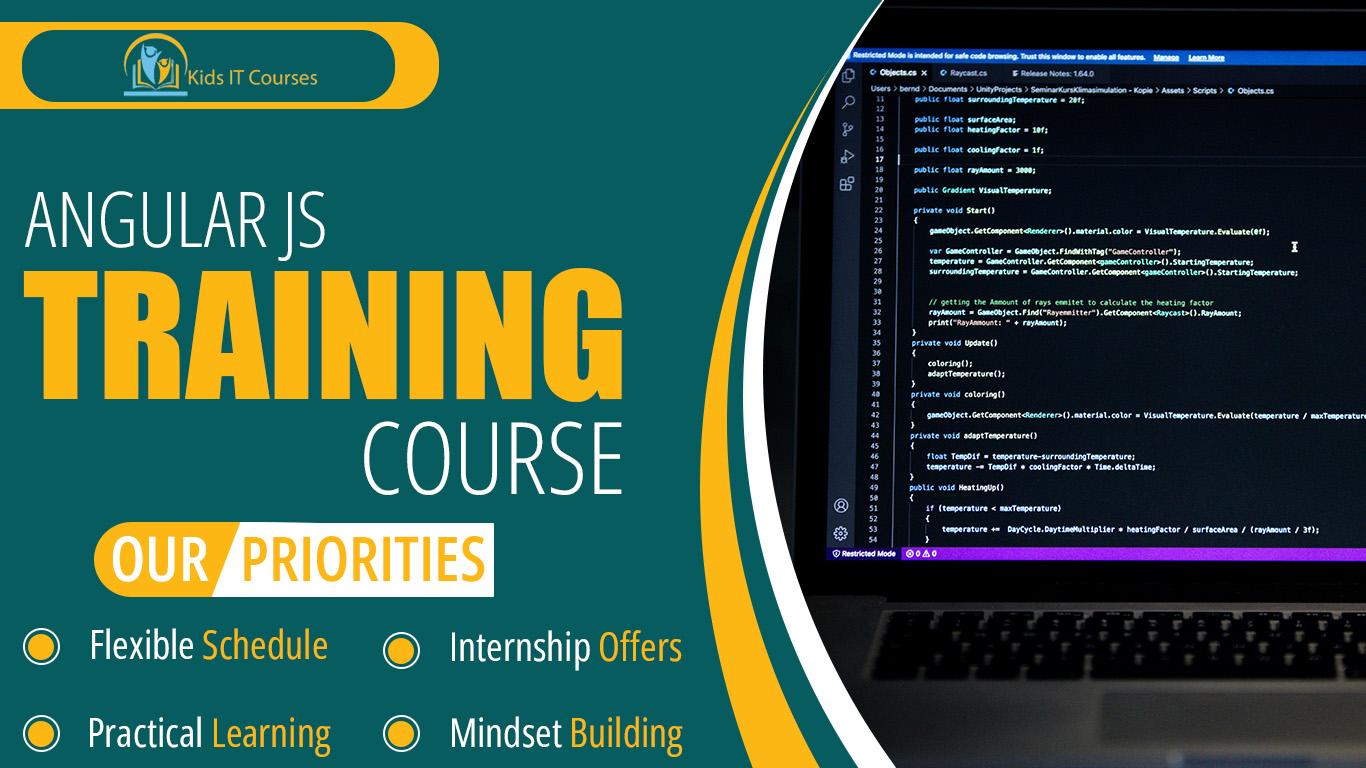
Angular JS Course for Kids
Definition
• AngularJS helps build websites. Kids make interactive pages.
• It uses JavaScript language. Easy and fun to learn.
• Kids create dynamic apps. Pages change without reload.
• They learn to use components. Building blocks for websites.
• Kids fix problems quickly. Make apps run smooth.
• It teaches coding and design. Work together in projects.
• Prepares kids for future tech. Web skills are very helpful.
Importance
• AngularJS helps build websites. Kids learn to make them faster.
• It uses JavaScript language. Easy to understand and fun.
• Kids create interactive pages. Websites that work well.
• They learn how apps update. Without reloading pages.
• It teaches coding and design. Working together smoothly.
• Kids improve problem-solving. Fix bugs and errors quickly.
•It prepares kids for tech jobs. Web development skills are useful.
Advantages for Freelancing
• Kids learn to build websites. AngularJS makes sites work well.
• It helps create cool apps. Apps that run fast and smooth.
• Kids understand how web works. They see how pages change.
• It teaches coding and design. Making learning fun and easy.
• Kids solve problems with code. Fix bugs and improve apps.
• It builds teamwork skills. Kids can work on projects together.
• Prepares kids for tech jobs. Web skills are very useful.
Session 1 : Introduction to Angular JS
What is Angular JS and why it’s used for building dynamic web apps
Real-life example: A modern e-commerce website with dynamic content (Angular JS in action)
Setting up Angular JS on your machine using Angular CLI
The architecture of Angular JS: Modules, Components, and Directives
Activity: Create your first Angular app with a simple greeting message
Session 2 : Angular Components and Templates
What are components in Angular and how they control the UI
Real-life example: A music player with play, pause, and volume controls (Angular components)
Understanding Angular templates and how they render data
Binding data in templates using
{{ }}interpolationActivity: Build a simple component with template rendering
Session 3 : Directives and Data Binding
What are directives in Angular JS and how they modify the DOM
Real-life example: A shopping list where items are displayed dynamically (directives in action)
Understanding data binding: one-way and two-way data binding
Using built-in directives like
ngIf,ngFor, andngModelActivity: Create a list app that adds/removes items using
ngForandngIf
Session 4 : Angular Services and Dependency Injection
What are services in Angular and how they help share data across components
Real-life example: A weather app that gets weather data from a service (services)
How Dependency Injection makes components reusable and decoupled
Using services for HTTP requests, state management, and logic
Activity: Create a service that fetches data from an API and displays it
Session 5 : Routing in Angular
What is Angular Routing and how it enables navigation between pages
Real-life example: An online store where you navigate from the homepage to product details (routing)
Setting up routes, using
RouterModule, and passing data with routesActivity: Build a simple multi-page app with Angular routing
Session 6 : Forms in Angular
Understanding template-driven forms and reactive forms in Angular
Real-life example: A user registration form that validates input fields (forms)
Using
ngModel,FormGroup, andFormControlfor form controlValidating forms and showing error messages
Activity: Create a user login form with validation and error handling
Session 7 : Angular Pipes and Observables
What are pipes in Angular and how they transform data in templates
Real-life example: A price filter that formats currency values (pipes)
Understanding Observables and how they handle asynchronous operations
Using RxJS operators to manage data streams in Angular
Activity: Create an app that filters data with custom pipes and handles async data with Observables
Session 8 : Final Project – Build a Complete Angular App
Plan and build a fully functional Angular app using components, services, routing, and forms
Implement dynamic data binding, routing, and form validation
Test your app for performance and functionality
Activity: Present your final Angular project, explaining key features and Angular concepts
Bonus Materials
Angular JS cheat sheet with component, directive, and service syntax
Links to Angular libraries and plugins for enhanced functionality
Resources for learning advanced Angular features
Interactive coding challenges and quizzes
Certificate of Completion for Angular JS Basics
